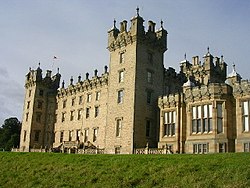Floors Castle
| Floors Castle | |
| Roxburghshire | |
|---|---|
 Floors Castle | |
| Location | |
| Grid reference: | NT71113467 |
| Location: | 55°36’17"N, 2°27’36"W |
| Town: | Kelso |
| History | |
| Country house | |
| Information | |
| Website: | www.roxburghe.net/castle |
Floors Castle, in Roxburghshire, is the seat of the Duke of Roxburghe. It Floors Castle stands beside the River Tweed, with fine views across to the Cheviot Hills.
Despite its name it is a country house rather than a fortress. It was built in the 1720s by the architect William Adam for John Ker, 1st Duke of Roxburghe, possibly incorporating an earlier tower house.[1] In the 19th century it was embellished with turrets and battlements by William Playfair for the 6th Duke.
Floors has the common 18th-century layout of a main block with two symmetrical service wings.
Floors Castle is now a category A listed building,[1] and the grounds are listed in the Inventory of Gardens and Designed Landscapes.[2]
The castle is opened to the public.
History

Background
The Ker family, Earls and Dukes of Roxburghe, have held lands in Roxburghshire since the 12th century. Their origins are not certain, but they were likely of Norman stock originally.[3] Since James Innes-Ker, 5th Duke of Roxburghe, succeeded to the title 1812, they have used the double-barrelled name "Innes-Ker".
The name of Floors Castle is thought to come either from "flowers" (or the French fleurs), or from the "floors", or terraces, on which the castle is built.[4]
Early history
Although the present Castle lacks all defensive capabilities, and was built in a period when private fortresses were redundant in the Middle Shires, there was possibly a tower house on the site. Tower houses, or pele towers, were typical of these lands; until the Union of the Crowns brought peace in 1603, the border lands, or "Marches" between Scotland and England were a lawless place where cattle raids, murder, private wars and reprisal attacks by bands of reivers were common. Floors also stands opposite the site of Roxburgh Castle, an important mediæval fortress (and where King James II was killed during a siege in 1460).
The lands of Floors were held by the monks of Kelso Abbey, until the Reformation, when they were granted to Robert Ker of Cessford (1570–1650, later the first Earl of Roxburghe) by King James VI.[5]
The country house
John, Earl of Roxburghe (1680–1741) played a role in securing the Union of Scotland and England in 1707, and was rewarded by being created Duke of Roxburghe. He commissioned the architect William Adam (1689–1748), father of the more famous Robert Adam, to design a new mansion incorporating the earlier tower house. It was built between 1721 and 1726, and comprised a plain block, with towers at each corner. Pavilions on either side housed stables and kitchens.[5]
Around 1837, James Innes-Ker, 6th Duke of Roxburghe (1816–1879) commissioned the fashionable architect William Playfair to remodel and rebuild the plain Georgian mansion house he had inherited. The present form of the building is the result of Playfair's work, and is in a similar style to his buildings at Donaldson's College, Edinburgh.[5]
In 1903, the 8th Duke married the American heiress Mary Goelet. She brought with her from her Long Island home a set of Gobelins Manufactory tapestries, that were incorporated into the ballroom in the 1930s, and added to the collection several modern pictures by Walter Sickert and Henri Matisse, among others.
On film
The castle featured in the 1984 film Greystoke: The Legend of Tarzan, Lord of the Apes.

Outside links
- Floors Castle
- CANMORE (RCAHMS) record of Floors Castle - photographs, aerial views, and architectural drawings
References

- ↑ 1.0 1.1 Floors Castle, Listed Building Report - Historic Scotland
- ↑ Floors Castle on 'An Inventory of Gardens and Designed Landscapes in Scotland'
- ↑ Paul, Sir James (1909). The Scots Peerage. Edinburgh: David Douglas. https://archive.org/stream/scotspeeragefoun07paul#page/314/mode/2up.
- ↑ Castle in the Country, BBC TV programme
- ↑ 5.0 5.1 5.2 Floors Castle - CANMORE (RCAHMS)